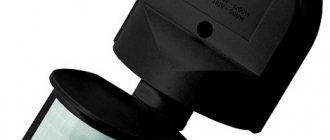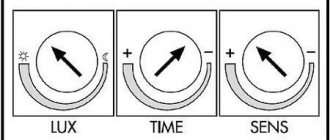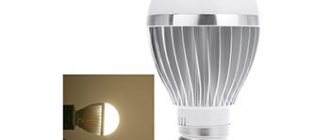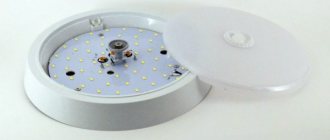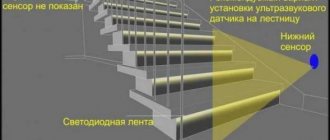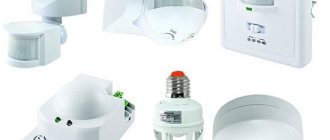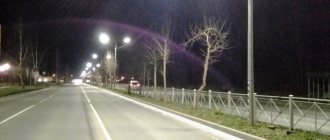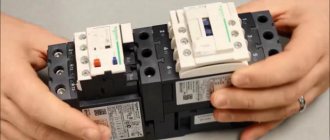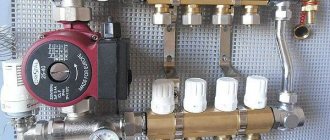An outdoor floodlight with a motion sensor can be used as an element of a security system. It allows you to save energy by turning on the lighting only if there is a moving object in the coverage area.
- Infrared wireless motion sensor: its action is based on the analysis of infrared radiation, which is invisible to the eye. The source of such radiation is the human or animal body. Adjusting a motion sensor of this type makes it possible to exclude the system from triggering the movement of animals whose body temperature is higher than that of humans.
- Pyroelectric: Generated electrical signals respond to the presence of a heat source (person) in the protected area. The sensor compares the level of the emitted and received signals and, if the difference exceeds the set value, sends a signal to turn on the light.
- Ultrasonic outdoor wireless sensor: based on receiving a reflected sound signal in a range inaccessible to the human ear. If the travel time and direction of signal propagation changes, the sensor turns on the spotlight.
Combined-action devices are also used. For the street, infrared photo sensors are most often used.
Expert opinion
Viktor Pavlovich Strebizh, lighting and electrical expert
Any questions ask me, I will help!
All these parameters, when properly configured, can save up to 50% of electricity, which is a very significant indicator. If there is something you don’t understand, write to me!
How does a photosensor work?
An outdoor motion sensor is a compact device in a sealed housing. It responds to changes in the intensity of infrared radiation, which is captured and directed by special lenses to the sensor. In turn, the photosensor sends a signal to the actuator (electromechanical relay) responsible for connecting the lighting device.
Intelligent street lighting systems are in demand for equipping the following facilities:
- car parking;
- industrial and enterprises;
- trading platforms;
- open-air warehouses;
- private estates, including household plots;
- military facilities;
- state borders.
The popularity of street motion sensors is explained by their advantages.
What kind of lighting do you prefer?
Built-in Chandelier
- Long service life (for LED devices).
- Easy installation.
- No special maintenance required.
- Economical energy consumption thanks to the characteristics of the LEDs and the connected sensor, which can be configured to trigger only when a moving object appears within the range of the device.
- Resistance to extraneous noise, vibration, temperature changes.
- High response speed.
- Can be installed anywhere as long as it has a solid base.
Principle of operation
How the spotlight works
When a constantly moving object is detected in the protected area, the illuminator turns on for a fixed time. After a certain time period, set by the selected delay, the light turns off until the sensor is triggered again. Then the whole process is repeated in the same order.
The function of the sensors that control the operation of the illuminator is usually performed by “passive” type IR sensors. The action of these devices is based on a change in the temperature background in the event of a person or animal appearing in the element’s sensitive zone. After registering it, the sensor generates a control pulse that turns on the spotlight for a specified time.
Types of spotlights and selection procedure
Among the well-known models of floodlights with DD, the following types stand out:
- devices operating with incandescent light bulbs or energy-saving light sources;
- more efficient halogen floodlights;
- LED devices designed for a voltage of no more than 12 Volts.
Each type of floodlights with a motion sensor for streets has its own advantages and disadvantages, taking them into account during the selection process is very important. All other things being equal, preference is given to the model that is best suited for the protected area.
LED floodlights are usually used to illuminate the entrances to a garage located on the territory or to the house itself.
Various types of illuminators with sensors provide sensitivity adjustment to adjust it to specific operating conditions. Once it is set correctly, the devices respond only to objects of a certain size. In addition, some models allow temporary adjustments that determine the delay in turning off the device after operation.
To choose a floodlight model with DD that is suitable for outdoor installation, you should follow two rules. First of all, you need to decide on the illuminator used in it, the choice of which determines the operational reliability of the device. Secondly, it is important to familiarize yourself with the parameters of the motion sensor that satisfy all the requirements for it.
Floodlight with motion and light sensor: operating principle and types
Combination sensors combine several motion detection methods. The most successful method is considered to be the joint operation of IR and microwave sensors. Parallel motion detection channels make the combined sensor work more efficiently and accurately.
Expert opinion
Viktor Pavlovich Strebizh, lighting and electrical expert
Any questions ask me, I will help!
The action of these devices is based on a change in the temperature background in the event of a person or animal appearing in the element’s sensitive zone. If there is something you don’t understand, write to me!
Varieties
At the moment there are several classifications of spotlights. So, there is a spotlight:
- industrial, street and decorative;
- for underwater, terrestrial, matrix, linear and panoramic lighting;
- LED, halogen and battery.
There is also the following classification: for indoor and outdoor lighting.
LED
The most popular and high-quality light source. Operates for 80 thousand hours. Does not require any maintenance throughout the entire period of use. It is used both in everyday life and in industry and commerce. Due to the high light flux density, it is used to illuminate a large area. The advantages include high efficiency, impact resistance, and safety. The disadvantage is the high cost.
LED apparatus
Solar powered
A modern system that allows you to completely eliminate network energy consumption. The floodlight is complemented by durable or built-in solar panels. They are used both to illuminate the facade of a building and an architectural element, and to maintain security and order in the local area. They work around the clock and autonomously, are very easy to install and maintain, and work regardless of the weather. It has an even and bright light flow and can be installed in any hard-to-reach place.
It is worth noting that during rain the performance of solar panels decreases. Therefore, sometimes the spotlight may turn off. Due to low temperatures, operation failure also occurs. The light becomes dimmer. Another disadvantage is that the equipment is not disassembled. As a result, if one element is damaged, you will need to completely buy new equipment.
Solar powered source
With halogen lamp
The halogen spotlight creates a spot-like, shadow-free lighting appearance that has a warm tint. This device is used to illuminate billboards or building facades. It is also used to illuminate large objects such as dams or bridges. The light bulb in it works the same way as an incandescent lamp. The only difference is the use of halogen instead of mercury. The advantages of such a device are low cost, high reliability and compatibility with dimmers. Disadvantages include high heating and energy consumption.
You might be interested in this All about the DRL 125 light bulb
There are also metal halide models. They are distinguished by a more powerful light flux, reliability and immunity to network current surges.
Note! They are actively used in commercial activities. They have a long service life.
Motion floodlight with built-in halogen lamps
Installation of spotlights
As a rule, there are no particular difficulties with installing a spotlight. First, a suitable place is selected where the device can record the slightest movements of foreign objects. It is determined so that the spotlight illuminates as large an area as possible and ensures its complete coverage.
Some samples of lighting devices allow operation from a backup battery connected to the power line in the event of a power outage. In this case, before installation it is necessary to provide a separate place for it, which must be reliably protected from bad weather.
The ease of installation of the device allows you to perform all operations yourself. You don't even need a tool for this. The delivery set includes a special bracket with which the spotlight is mounted in the selected location.
Posting rules
For more efficient use and maximum savings of electricity, DDs should be installed in those places where there is the greatest movement of people and large pets. This is done not only indoors, but also outdoors, for example, in the courtyard of your own house.
Depending on the type of installation, sensors are:
The principle of operation of each of them does not change. It all depends on local conditions. But, nevertheless, ceiling ones are more used in small rooms. It is recommended to install them at a height of 2.5 to 3 meters. Thus, the sensor will be able to cover an area with a diameter of 10–20 meters.
Wall sensors are used both indoors and outdoors. Accordingly, they have found wide application in outdoor lighting electrical networks. The installation height of such DDs indoors is slightly lower than that of ceiling ones, and is 2–2.5 meters. Of course, you can install wall sensors anywhere, but experts recommend doing it in a corner of the room. This results in a larger viewing angle. If the installation is carried out on the street, then it needs to be directed towards greater traffic of people.
DD adjustment
When installing a floodlight with DD, first of all, position the device in such a way that the observation area is largest. The height of the placement and the angle of its installation are important. The installation angle is adjustable using a hinged mount, and the vertical viewing parameters are indicated in the operating instructions.
The operating parameters of the spotlight with DD are adjusted using controls, the handles of which are located on the sensor body for convenience. They are located at the bottom of the DD and are marked accordingly.
LUX (illuminance) – when adjusting the level of illumination, set the regulator to the MIN position. In this case, the DD will only work in complete darkness. If necessary, the illumination level is changed.
TIME (delay time) – sets the amount of time the spotlight will operate after a moving object leaves the observation area. As a rule, the time delay is set in the range of 5 seconds. up to 8 min.
Street floodlight with motion sensor: types, connection, configuration
They are often installed in the area of door passages, which, along with lighting, allows you to control the movement of unauthorized persons and significantly expands the scope of application.
Expert opinion
Viktor Pavlovich Strebizh, lighting and electrical expert
Any questions ask me, I will help!
Economical energy consumption thanks to the characteristics of the LEDs and the connected sensor, which can be configured to trigger only when a moving object appears within the range of the device. If there is something you don’t understand, write to me!
Device setup
The LED floodlight with motion sensor is equipped with several switches. With their help you can configure:
- sensitivity of the photo relay - its reaction to large and small objects depends on this parameter;
- illumination: you can adjust the time the spotlight is active, for example, set it to operate only during twilight hours;
- operating time—sets the time interval for street lighting during which the spotlight will operate after the photo relay is triggered.
By setting up a device for street lighting, we achieve its optimal operation in terms of operating mode and energy saving.
How to connect a motion sensor to a spotlight: connection diagrams
- possibility of false alarms (response to any thermal radiation);
- low accuracy of work outdoors due to exposure to direct sunlight and precipitation;
- does not react to shielded objects that do not transmit IR radiation;
- insufficient operating temperature range.
Useful tips Connection diagrams Principles of operation of devices Main concepts Meters from Energomer Precautions Incandescent lamps Video instructions for the master Testing with a multimeter
Which lamp to choose
When choosing a spotlight, you need to pay attention not only to the power, shape and availability of auxiliary functions, but also to the main element - the lamp. There are several types of devices:
There are several types of devices:
- LED;
- halogen;
- metal halide;
- sodium
A distinctive feature of the first option is efficiency and long service life. Most manufacturers prefer this option. Buyers like these designs because of the following advantages:
- low energy consumption;
- resistance to vibration load;
- can be used even at negative or high temperatures;
- autonomy is supported, especially if the device has low power;
- service life up to 100,000 hours;
- turns on and off an unlimited number of times;
- ability to control using a smartphone;
- simple color change.
There are also disadvantages, for example, the cost of a model with advanced capabilities can reach 5 or even 10 thousand rubles, therefore, if a person does not require additional options, it is better to buy a standard product.
A distinctive feature of halogen versions is their low cost. Such products have high color rendering, so they are suitable for organizing light during construction work. The only drawback is the service life, which rarely exceeds 4000 hours
At the same time, it is important to be vigilant when choosing a case. If you plan to use the spotlight continuously, then it is better to give preference to options with a metal casing, because during active operation a large amount of heat is generated
Metal halide products are equipped with a gas discharge lamp with high luminous efficiency. The advantage of this option is its high resistance to surges and voltage drops in the electrical network. Various models are sold, ranging from 20 to 150 W and above.
Sodium lamps have one drawback - poor color rendering, so they are used only in places where there are no strict lighting requirements. Like the previous options, the power of this version varies, it all depends on preferences and area of use. Service life is standard.
